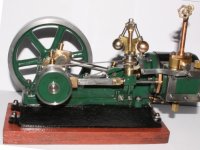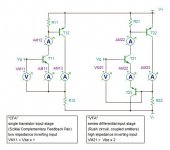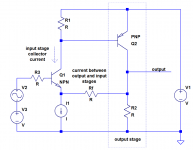In the widest possible sense You could put up any machine and ask the same question I guess. How the output controlled variable is sampled and then transformed into a suitable signal for processing in the difference engine is very machine dependent. It obviously volts or amps in the audio amplifier context we are discussing here.
My view on feedback is that it is a natural phenomena eg see stellar thermo- nuclear temperature regulation for example - we only discovered it and can now enjoy its benefits. Another example would be metabolic pathways in living organisms - serious multi-loop, multi- order systems.
Luckily, this is audio and it’s the simple stuff.
My view on feedback is that it is a natural phenomena eg see stellar thermo- nuclear temperature regulation for example - we only discovered it and can now enjoy its benefits. Another example would be metabolic pathways in living organisms - serious multi-loop, multi- order systems.
Luckily, this is audio and it’s the simple stuff.
Last edited:
This configuration is not clear to me as there is necessarily a load. I join a schematics of the simplest CFA and VFA unity gain circuits to help.One could argue that it delivers, accepts, or does both.
Can we agree that for a CFA configured for unity voltage gain (no Rg) that the input stage collector (non-bias) current is substantially the same current that flows (exclusive of any load) from (or into, if you prefer) the output stage?And if we add an Rg, that the collector current is the same current as some fraction of that which flows from/into the output stage?
So there is no distinction between CFA and VFA if C and V which, if not suggesting the way the output is controlled (first old meaning) should suggest the way the feedback controls the internal values, it is clearly not the new meaning for CFA.And that if we restrict ourselves to non-zero and non-infinite impedances, no current or voltage exists without giving rise to the other, and so if a phenomenon can be explained by referring to one, it can also be explained by referring to the other? In light of this, what forces one to reject as technically incorrect the claim that current is fed from the output stage back to and through the input stage (current feedback)?
Attachments
Last edited:
Yes. so?
The title is under Current Mode Amplifiers. The proper term for the amplifier talked about here. THx-RNMarsh
You continue to discuss "terms". I do not contest anyone's declaration of a "proper term". But I will note that the term "Current Mode" explains virtually nothing, and requires further clarification to be of any value other than to assign a name to a circuit.
I claim that the amplifier functions by employing current feedback, as clearly does the technologist who patented one of the first commercial implementations of the circuit. He may have named it Current Mode in the patent, but he explained its operation therein by using the technical phrase "current feedback."
Do you believe that he was wrong? Do you deny that the device employs current feedback?
This configuration is not clear to me as there is necessarily a load.
Please see attached schematic of a simple CFA. Would you kindly refer to it and reply to the questions I listed in my prior post?
Chris,
Reducing it to essentials helps clarify the issues.
The output (collector) current from the input transistor is the current sourced from the emitter, which is the current sourced from the output stage through the feedback network.
If you are familiar with the superposition principle (I know you are), then seen from the inverting 'CFA' input, that input transistor works in common base, Ie = Ic, that Ic being amplified to form the output current.
The output current of Q1 is the current that comes in through Rf - there isn't any other way.
So it's currents all around, a strong argument that indeed it is current feedback; the output current of the input transistor is current fed back from the output through Rf.
Jan
Reducing it to essentials helps clarify the issues.
The output (collector) current from the input transistor is the current sourced from the emitter, which is the current sourced from the output stage through the feedback network.
If you are familiar with the superposition principle (I know you are), then seen from the inverting 'CFA' input, that input transistor works in common base, Ie = Ic, that Ic being amplified to form the output current.
The output current of Q1 is the current that comes in through Rf - there isn't any other way.
So it's currents all around, a strong argument that indeed it is current feedback; the output current of the input transistor is current fed back from the output through Rf.
Jan
Last edited:
This circuit attempts to control the difference between input and output voltage. If you are talking about what is being controlled then this is voltage feedback. If you are talking about the nature of the feedback path then it is unclear to me.
Where do you draw the line between calling a feedback path current and calling it voltage? All feedback paths involve both by definition. You could talk about the impedance of the path but you would still need to qualify what counts as high or low.
Is there any practical point to this debate?
Where do you draw the line between calling a feedback path current and calling it voltage? All feedback paths involve both by definition. You could talk about the impedance of the path but you would still need to qualify what counts as high or low.
Is there any practical point to this debate?
In my machine example (post 741) I was trying to show what conventions are. It would be normal to speak of the machine having speed feedback because this is what is sensed and what is being controlled. It would be odd to call it, say, force feedback because that's not what is being controlled, even though force plays a key roll in the governor.
I have difficulties with the role of Rf. To me it's a degeneration resistor for Q1.Schematic updated with Rf.
The input transistor works in common base in open loop.that input transistor works in common base
In close loop, it works like an emitter follower (with a light load in its collector).
It imposes its emitter voltage to the emitter load (the feedback network).
The remaining part of the circuit adds current to the load and to the feedabck network, so it increases the impedance of the feedback network. The emitter current has less current to provide, the emitter voltage commands the whole.
Think of a Sziklai pair. Has anybody ever analyzed it as having an input transistor working in common base ?
This circuit attempts to control the difference between input and output voltage.
CPaul - the one in my most recent post? yes.
If you are talking about what is being controlled then this is voltage feedback.
Cpaul - conclusion does not follow from premise. For instance, with a PLL, I might control a frequency. Frequency is not being fed back to the error amplifier.
If you are talking about the nature of the feedback path then it is unclear to me.
Cpaul - not sure what "nature of the feedback path" means.
Where do you draw the line between calling a feedback path current and calling it voltage?
Cpaul - not calling the path anything.
All feedback paths involve both by definition.
Cpaul - I've made that point already.
You could talk about the impedance of the path but you would still need to qualify what counts as high or low.
Cpaul - not interested in talking about the impedance of the path.
Is there any practical point to this debate?
Cpaul - understanding circuits. Particularly, that those employing current feedback have different characteristics from those using voltage feedback. Generally, slew rate enhancement on demand, and nearly constant bandwidth over a range of closed loop gains is inherent in designs employing current feedback. Surely there is a benefit in identifying these clear distinctions?
If the signal current flowing in an input stage is the current flowing from amplifier's output, then I can't think of anything that would better qualify the situation as a case of current feedback (reference CFA's). If instead that current comes from the input stage itself, such as with a triode long-tailed pair, then there is no current feedback - the voltage difference between the grids steers input stage bias current to one triode or another (VFA).
I have difficulties with the role of Rf. To me it's a degeneration resistor for Q1.
Could you answer my questions if you set Rf to zero?
In my machine example (post 741) I was trying to show what conventions are. It would be normal to speak of the machine having speed feedback because this is what is sensed and what is being controlled. It would be odd to call it, say, force feedback because that's not what is being controlled, even though force plays a key roll in the governor.
I don't think we disagree with what we call the machine. In both the CFA and VFA topology case (assuming conventional audio amplifier usage) you would have a voltage output amplifier (low Zout, high current drive capability to drive the speaker).
The form that the feedback from the voltage output back to the error amplifier however does not have to be a voltage - and in a CFA it is not - its a current.
You have to distinguish between the output controlled quantity and form that the feedback representation takes.
In the case of your machine, its output is speed controlled, but the representative feedback signal might be in a different form - like force as you quote.
Yes it is.Cpaul - conclusion does not follow from premise. For instance, with a PLL, I might control a frequency. Frequency is not being fed back to the error amplifier.
Incoherent.If you are talking about the nature of the feedback path then it is unclear to me.
Cpaul - not sure what "nature of the feedback path" means.
Where do you draw the line between calling a feedback path current and calling it voltage?
Cpaul - not calling the path anything.
All feedback paths involve both by definition.
Cpaul - I've made that point already.
You could talk about the impedance of the path but you would still need to qualify what counts as high or low.
Cpaul - not interested in talking about the impedance of the path.
I don't think so. It may be inherent in low impedance feedback paths.Is there any practical point to this debate?
Cpaul - understanding circuits. Particularly, that those employing current feedback have different characteristics from those using voltage feedback. Generally, slew rate enhancement on demand, and nearly constant bandwidth over a range of closed loop gains is inherent in designs employing current feedback. Surely there is a benefit in identifying these clear distinctions?
No. There is always current fed back.If the signal current flowing in an input stage is the current flowing from amplifier's output, then I can't think of anything that would better qualify the situation as a case of current feedback (reference CFA's). If instead that current comes from the input stage itself, such as with a triode long-tailed pair, then there is no current feedback - the voltage difference between the grids steers input stage bias current to one triode or another (VFA).
Exactly. So I think people should make it clear which one they are talking about. The term CFA can be interpreted either way.You have to distinguish between the output controlled quantity and form that the feedback representation takes.
- Home
- Amplifiers
- Solid State
- Current Feedback Amplifiers, not only a semantic problem?


